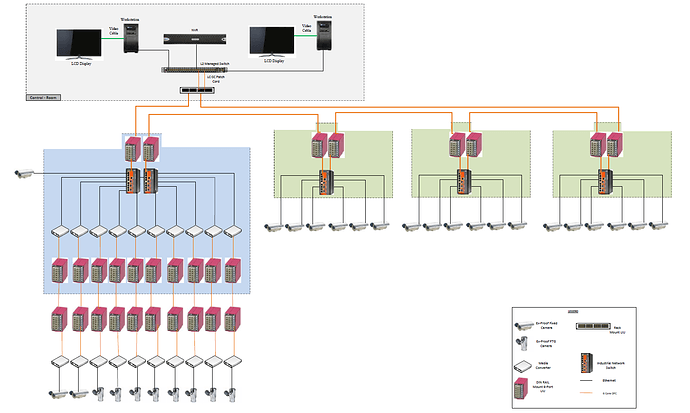Industrial Ethernet Switch
A switch is a device in a computer network that connects other devices together. Multiple data cables are plugged into a switch to enable communication between different networked devices.
Switches manage the flow of data across a network by transmitting a received network packet only to the one or more devices for which the packet is intended.
Each networked device connected to a switch can be identified by its network address, allowing the switch to direct the flow of traffic maximizing the security and efficiency of the network.
A switch is more intelligent than an Ethernet hub, which simply re transmits packets out of every port of the hub except the port on which the packet was received, unable to distinguish different recipients, and achieving an overall lower network efficiency.
Vibrations, shocks, and electrical noise also separate the sheep from the goats when it comes to Ethernet switches. Industrial environments typically use DIN-rail mounting instead of the 19-in. rack mounting that is standard for business IT installations.
Industrial network switches are designed to avoid vibration or shocks that could make cables fall out and to meet industrial EMC (electromagnetic compatibility) standards. By comparison, business IT switches are less resistant to vibrations, shocks, and electrical noise currents that can cause component burnout and other electrical damage.
The components used to build authentic industrial network switches are designed and tested for operation in broad operating temperature ranges, for example from -40 to +75°C (-40 to +167°F).
Commercial switches are built for operation within much narrower temperature ranges. Outside these limits, their integrated circuits may fail when temperatures are high, or their network connections may lose their contact because of the cold.
Industrial network switches are built to work in harsh conditions such as manufacturing, transport, maritime, oil & gas, and mining. They are designed for high availability over long periods because downtime costs in industrial environments are often considerable.
Business IT switches may have a life cycle of only 1.5 to 3 years; industrial Ethernet switches may be kept working for 10 years or more.
Media converter
A media converter is a device used to connect media that would otherwise be incompatible. It is used to link fiber optic cable to twisted pair for supporting Ethernet-compatible devices.
DIN rail mounted LIU
Din Rail liu is designed to support fusion splicing or direct termination of the fibers. Because of its compact and ruggedly designed case, it is suitable for industrial applications. Din rail mounted patch panel includes a splice tray for fusion splicing.
Din rail enclosure is compact in size and can be mounted on the cabinet with other din rail equipment where there is space constraint inside PLC’s. Din Rail mount enclosures are suitable to mount in substation automation networks and these can be used to provide a maximum number of fiber connections in a minimal footprint.
Din rail mount fiber patch panel is used in CCTV traffic monitoring, toll systems and environmental monitoring equipment where these can be secured in small wayside cabinet back-plane or side panel. The patch panel can be loaded with a variety of adapters like ST, SC, FC and LC.
Rack mounted LIU
Fiber Optic Interconnection Units are the smaller basic cabinets and enclosures used in interconnecting, cross-connecting, or splicing applications in LANs at a premise location
